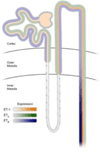Endothelin and renal ion and water transport
- PMID: 25966345
- PMCID: PMC4499165
- DOI: 10.1016/j.semnephrol.2015.02.003
Endothelin and renal ion and water transport
Abstract
The renal tubular epithelial cells produce more endothelin-1 (ET-1) than any other cell type in the body. Moving down the nephron, the amount of ET-1 produced appears fairly consistent until reaching the inner medullary collecting duct, which produces at least 10 times more ET-1 than any other segment. ET-1 inhibits Na(+) transport in all parts of the nephron through activation of the ETB receptor, and, to a minor extent, the ETA receptor. These effects are most prominent in the collecting duct where ETB-receptor activation inhibits activity of the epithelial Na(+) channel. Effects in other parts of the nephron include inhibition of Na(+)/H(+) exchange in the proximal tubule and the Na(+), K(+), 2Cl(-) co-transporter in the thick ascending limb. In general, the renal epithelial ET-1 system is an integral part of the body's response to a high salt intake to maintain homeostasis and normal blood pressure. Loss of ETB-receptor function results in salt-sensitive hypertension. The role of renal ET-1 and how it affects Na(+) and water transport throughout the nephron is reviewed.
Keywords: Endothelin; kidney; sodium transport.
Copyright © 2015 Elsevier Inc. All rights reserved.
Conflict of interest statement
Figures



References
-
- Yanagisawa M, Kurihara H, Kimura S, Goto K, Masaki T. A novel peptide vasoconstrictor, endothelin, is produced by vascular endothelium and modulates smooth muscle Ca2+ channels. J Hypertension. 1988;6:S188–S191. - PubMed
-
- Zeidel ML, Brady HR, Kone BC, Gullans SR, Brenner BM. Endothelin, a peptide inhibitor of Na+-K -ATPase in intact renaltubular epithelial cells. Am J Physiol. 1989;257:C1101–C1107. - PubMed
-
- Garvin J, Sanders K. Endothelin inhibits fluid and bicarbonate transport in part by reducing Na+/K+ ATPase activity in the rat proximal straight tubule. J Am Soc Nephrol. 1991;2:976–982. - PubMed
-
- Eiam-Ong S, Hilden SA, King AJ, Johns CA, Madias NE. Endothelin-1 stimulates the Na+/H+ and Na+/HCO3− transporters in rabbit renal cortex. Kidney Int. 1992;42:18–24. - PubMed
Publication types
MeSH terms
Substances
Grants and funding
LinkOut - more resources
Full Text Sources
Other Literature Sources

